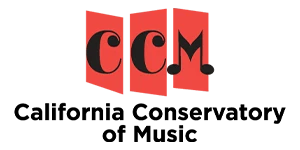The Academic Benefits of Music Lessons

In the fast-paced world we live in, every parent seeks to equip their child with the tools they need for academic success. Among these tools, music lessons have emerged as a unique and powerful means of enhancing a child’s educational journey. The academic benefits of music lessons extend far beyond the realm of rhythm and melody. As a parent, understanding how music education can positively influence your child’s academic performance can be crucial in making informed decisions about their extracurricular activities.
The Connection Between Music and Cognitive Development
A growing body of research supports the link between music lessons and cognitive development in children. Studies have shown that children who receive music education often display improved memory, attention span, and problem-solving skills. Learning music engages and strengthens multiple areas of the brain, thus leading to cognitive improvements.
The process of learning to read music and understand rhythm involves significant mental coordination and discipline. As a result, this translates into enhanced concentration skills and a better ability to focus on academic tasks. Additionally, the academic benefits of music lessons include improved memory retention. The practice of memorizing music pieces can boost the brain’s ability to store and recall information, a skill that is transferable to academic subjects.
Enhancing Language Skills
One of the most significant academic benefits of music lessons is the development of language skills. Music and language are closely connected in the brain, and engaging in music education can enhance a child’s linguistic abilities. Understanding rhythm and melody develops the same auditory skills needed for recognizing the nuances of language, which can lead to improved reading and comprehension abilities.
Moreover, learning an instrument requires a child to process and interpret written musical notes, a skill akin to reading words. This correlation between reading music and reading text can foster stronger literacy skills, making music education a valuable asset for language development.
Mathematics and Music: An Interconnected Learning Experience
Moreover, mathematics and music are more closely linked than they appear. The academic benefits of music lessons in improving mathematical skills are well-documented. Music is inherently mathematical; it involves understanding scales, rhythms, and time signatures, which are all based on numerical concepts.
Furthermore, children who study music are often better at recognizing patterns, a skill that is fundamental in mathematics. The process of reading music involves counting beats and rhythms, reinforcing the understanding of division, fractions, and patterns. This can translate into a more intuitive grasp of mathematical concepts in school.
Boosting Confidence and Motivation
Another significant advantage of music lessons is the enhancement of a child’s self-esteem and motivation. Mastering a musical instrument is a rewarding experience that can boost confidence. This confidence often spills over into academic pursuits, encouraging children to take on new challenges with a positive attitude.
Moreover, the discipline and dedication required to learn music are skills that are directly applicable to academic studies. Children who engage in music lessons learn the value of regular practice and perseverance. These are essential traits for achieving academic goals and tackling challenging subjects in school.
Social and Emotional Development
Cognitive and technical skills are not the only academic benefits of music lessons. Music education plays a crucial role in the social and emotional development of children. Participating in a choir, orchestra, or band teaches children the importance of teamwork, cooperation, and social interaction. These experiences can foster a sense of belonging and improve social skills, which are vital for a well-rounded academic experience.
Emotionally, music provides an outlet for expression and can help children process and communicate their feelings effectively. This emotional awareness and expression are crucial for mental well-being, directly impacting a child’s ability to focus and perform academically.
—
Overall, the cumulative impact of music education on a child’s academic performance can be profound. Children who engage in music lessons often exhibit better grades and higher test scores. This can be attributed to the enhanced cognitive skills, improved concentration, and increased confidence that music education fosters.
In addition, music education can ignite a love for learning and curiosity that extends beyond music. Children who are exposed to music often develop a broader interest in other academic subjects, leading to a more enriching educational experience.
Making Music Education Accessible
As a parent, it’s essential to recognize that the academic benefits of music lessons are within reach for every child. It’s not about creating prodigies but about enriching your child’s educational journey. At the California Conservatory of Music, we believe in making music education accessible and enjoyable for every child. Our tailored programs cater to the individual needs and interests of each student, ensuring a positive and fulfilling learning experience.
As we embark on a new year, it’s the perfect time to consider incorporating music lessons into your child’s life. The academic benefits of music lessons are clear and far-reaching. From enhanced cognitive abilities and improved language skills to better mathematical understanding and increased confidence, music education is an invaluable investment in your child’s academic and personal development.
At the California Conservatory of Music, we’re dedicated to providing top-quality music education that nurtures your child’s academic growth and fosters a lifelong love for music. We invite you to explore the world of music with us and witness the transformative power of music education in your child’s life.

Harry Burleigh – February Composer of the Month
![ComposerMusician of the Month [POST] (1) harry burleigh](https://thecaliforniaconservatory.com/wp-content/uploads/elementor/thumbs/ComposerMusician-of-the-Month-POST-1-qnad9adr28ow95peuh79qvufujbuge3mx0a51krj1o.png)
In the pantheon of American composers, Harry Burleigh holds a special place. As the California Conservatory of Music‘s Composer of the Month for February, we celebrate Burleigh not just for his musical genius but also for his role in shaping the American musical identity. His life and work offer a fascinating glimpse into the evolution of American music, blending African American folk music with classical traditions.
Early Life and Influences
Born on December 2, 1866, in Erie, Pennsylvania, Harry Thacker Burleigh was immersed in music from a young age. His mother and his grandfather, a instilled in him a deep love for spirituals. This early exposure to African American folk music would later become a cornerstone of his musical style.
Burleigh’s talent was evident early on. He possessed a rich, baritone voice that caught the attention of many and led to his acceptance at the National Conservatory of Music in New York City in 1892. This was a significant achievement, especially considering the racial barriers of the time.
Burleigh’s Career and Breakthroughs
At the National Conservatory, Burleigh encountered famous Czech composer, Antonín Dvořák. Coincidentally, Dvořák served as the school’s director at the time. This meeting proved pivotal for Burleigh’s career and inspiration. Dvořák recognized the uniqueness of African American spirituals and encouraged Burleigh to incorporate these into his compositions. Burleigh, in turn, introduced Dvořák to a wealth of African American spirituals and folk songs, which influenced Dvořák’s own work, notably his “Symphony No. 9” (From the New World).
Burleigh’s career spanned both performance and composition. As a singer, he became one of the first African Americans to sing professionally in a New York City concert venue. Additionally, he was a soloist at St. George’s Episcopal Church in Manhattan for over 50 years. His contributions to the church music repertoire are substantial and everlasting.
Music and Legacy
Burleigh’s most enduring legacy lies in his arrangements of African American spirituals. He transformed these works from simple songs into artful pieces suitable for concert stages, thus preserving an essential part of African American heritage and sharing it with wider audiences.
His arrangement of “Deep River” in 1916 is particularly notable. It was one of the first times an African American spiritual was adapted for a classical music setting. This opened the door for other composers to explore this genre! Burleigh’s work in this area was not just musical; it was a form of cultural preservation.
Apart from spirituals, Burleigh composed art songs and instrumental pieces. His “Southland Sketches,” written for violin and piano, blends African American melodies with classical forms, showcasing his unique compositional voice.
Harry Burleigh’s Influence and Recognition
Furthermore, Burleigh’s influence extended well beyond his own compositions. He was a mentor to many younger African American musicians, helping to pave the way for future generations of artists. His advocacy for African American music as a vital part of the American musical landscape helped to break down racial barriers in the arts.
Throughout his career, Burleigh received numerous honors and accolades. In 1917, he was awarded the Spingarn Medal by the NAACP for his achievements as a musician and for his efforts to bring African American music to a broader audience.
A Strong Legacy
Burleigh’s life was not without challenges. He faced racial prejudice and discrimination, both personally and professionally. However, he met these challenges with dignity and grace, never allowing them to hinder his commitment to music and cultural expression.
Harry T. Burleigh passed away in 1949, but his influence resonates to this day. He was a trailblazer who not only broke racial barriers but also created a musical legacy that enriched the American cultural tapestry. His work in bringing African American spirituals to the concert stage opened doors for future generations of musicians and composers, ensuring that this vital part of American heritage would not be forgotten.
As we celebrate Burleigh this Black History Month, we are reminded of the power of music to transcend barriers, to preserve history, and to enrich the human spirit. Harry Burleigh’s life and music continue to inspire, serving as a testament to the enduring power of art to effect change and foster understanding.
Sign up for a free introductory lesson at The California Conservatory of Music!

February Voice Student of the Month – Sayuri Stock
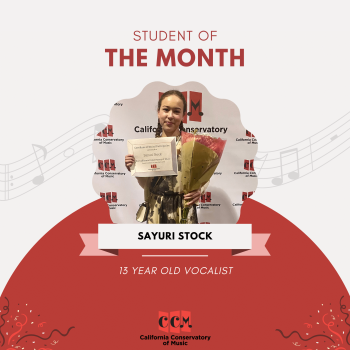
This February, we’re honored to highlight CCM voice student, Sayuri Stock, as our Student of the Month! Sayuri has been taking voice lessons with teacher Kaori at our Redwood City location since July of 2023! She has showed commitment and dedication to her voice lessons. Teacher Kaori says she always comes prepared to lessons and maintains a great attitude! Sayuri was also recently cast as Mary Poppins in her school’s production of Mary Poppins! Congratulations, Sayuri!
Student of the Month Questionnaire – Sayuri Stock
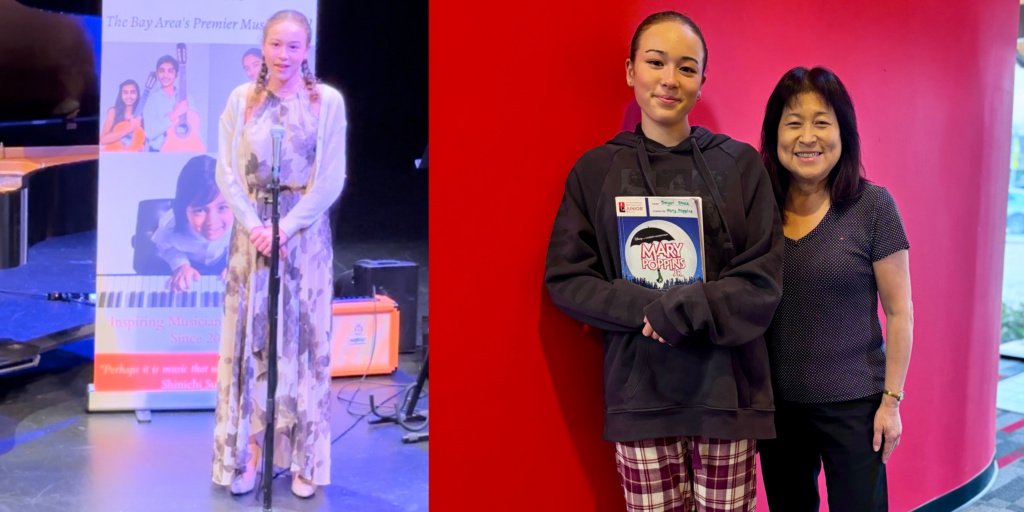
Parent Spotlight – Rika Onizuka
Getting the part of Mary Poppins in the upcoming school musical.
I feel that the arts and music are an important part of a child’s education and experience.

2024 Winter Music Recitals Recap: A Musical Success!
From everyone at the California Conservatory of Music, we extend our heartfelt thanks and congratulations to all the performers of our 2024 winter recitals. Over the past two weekends, we were thrilled to showcase the talents of over 1,000 violin, guitar, piano, and voice students at the Mountain View Center for the Performing Arts. Each recital, brimming with supportive family and friends, was a testament to the dedication and hard work the students and teachers have put into their music lessons over the past few months.

Students as young as three and a record number of adult students took the stage to perform, showcasing the diverse range of talent at CCM. For some, it was their very first time performing on stage, while for others, it marked one of their last CCM recitals before heading off to college. Each student showed incredible bravery and dedication.
We already can’t wait to hear everyone at the solo recitals in the Spring and at the ensemble recital in June.
Happy Practicing!
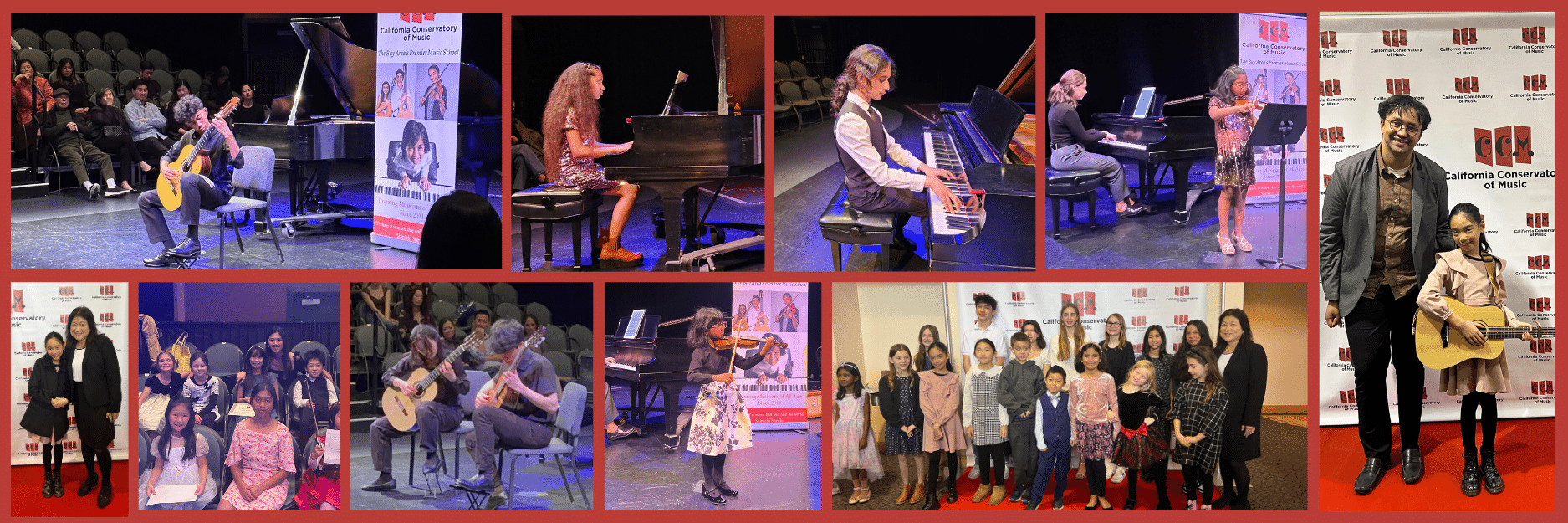
January Piano Student of the Month – Adam Benhamida
![Student of the Month [POST] adam (young boy) sitting at the piano facing the camera](https://thecaliforniaconservatory.com/wp-content/uploads/elementor/thumbs/Student-of-the-Month-POST-qnaddfu38wdhj5oblrsy9c4qasv7g9kyhk0ccklxkc.png)
This January, we’re happy to spotlight CCM piano student, Adam Benhamida, as our Student of the Month! Adam has been taking piano lessons at CCM for 8 months with teacher Nick at our Redwood City location! He always shows enthusiasm when it comes to learning new music. Teacher Nick says he does a great job of learning from his mistakes. Adam he practices well in preparation for lessons and makes great progress!
Student of the Month
What is your name?
Adam Benhamida.
How old are you?
I am nine.
Who is your teacher?
My teacher is Teacher Nick
What advice would you give to a piano student just starting out at CCM?
My advice would be that at the beginning it might be rough, and there might be some moments when you feel like quitting, but don’t give up, there will always be someone who will inspire you to do better.
What piece are you looking forward to learning someday?
I actually don’t know, but I’m sure I will like it.
What is your favorite thing about playing piano?
The music that the piano makes takes me into a different world that is so dramatic like I am winning a gold trophy.
What is your favorite food?
Pasta with beef bolognese (but I do like fettucini the best).
Do you have a pet?
No!
Do you play any sports or do any other activities outside of music lessons?
Yes I do swimming and soccer.
What do you want to be when you grow up?
A lawyer.
What is your most memorable experience at CCM?
When Teacher Nick told me one day that I’m going to have my first piano recital I sort of sparked to life telling myself that I was a real pianist.
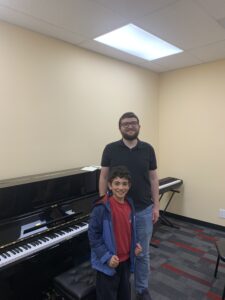
Parent Spotlight – Mahdi Benhamida
Regarding piano instruction, what are you most proud of your child accomplishing?
I’m very proud of Adam’s quick progress and his determination in improving his piano skills. He has done this on his own and without any pressure from his parents.
What advice would you give a new parent starting in the program?
To be very patient in the beginning when the student is learning and not give up too quickly. Eventually, once the student starts playing full songs, it’ll become more enjoyable. Having a good teacher who can support the student in this first phase is also key.
Why did you decide to give your child a musical upbringing?
This is more of a selfish reason but as a child, I always wanted to learn the piano but for various reasons, I was never able to do so. I’m hoping that when I have more time in the future, I’ll also start learning. Maybe Adam will be my teacher 🙂
Sign up for your free trial lesson at the California Conservatory of Music!

Philip Glass: January Composer of the Month
![ComposerMusician of the Month [POST] Philip Glass Composer of the Month title image](https://thecaliforniaconservatory.com/wp-content/uploads/elementor/thumbs/ComposerMusician-of-the-Month-POST-qnadebslp9l8hwdwf5m9m42ehwhopz3txy6unzajos.png)
In the world of contemporary classical music, few names shine as brightly as Philip Glass. Known for his distinctive style of minimalism, Glass has transformed the landscape of 20th and 21st-century music. As the California Conservatory of Music‘s January Composer of the Month, we delve into the life, career, and enduring influence of this iconic composer.
Early Life and Background
Philip Glass was born on January 31, 1937, in Baltimore, Maryland. His journey into the world of music began early. It was sparked by a deep fascination with the violin and flute recordings his father brought home. His father was a radio repairman and record store owner, so he had access to interested new music and sounds. This exposure to classical and popular music laid the foundation for Glass’s future explorations in music.
Glass’s formal music education started at the Peabody Institute’s preparatory school in Baltimore, where he studied the flute. His early exposure to composers such as Beethoven and Mozart at the school, coupled with his later discovery of modernist composers like Shostakovich and Bartók, broadened his musical perspectives significantly.
Educational Pursuits and Early Career
Glass went on to study at the University of Chicago, where he majored in mathematics and philosophy – disciplines that would later influence his structured, yet emotive, compositional style. After graduating, he moved to New York to attend the Juilliard School, studying composition further.
The late 1960s and early 1970s were a period of significant artistic development for Glass. He spent time in Paris studying under the renowned Nadia Boulanger and worked closely with sitar virtuoso Ravi Shankar on film scores. These experiences introduced him to non-Western musical structures, particularly Indian classical music, which would play a crucial role in shaping his unique approach to composition.
Glass’s Career and Rise to Prominence
Philip Glass’s emergence as a leading figure in minimalism began in the late 1960s and early 1970s. His early works, such as “Music in Similar Motion” (1969) and “Music in Twelve Parts” (1971-1974), showcased his developing style characterized by repetitive structures, evolving patterns, and a dramatic use of rhythm and harmony.
However, it was the opera “Einstein on the Beach” (1976), created in collaboration with director Robert Wilson, that catapulted Glass to international fame. This groundbreaking work eschewed traditional narrative for a non-linear approach, featuring repetitive musical and vocal patterns that created a hypnotic soundscape. The success of “Einstein on the Beach” marked a turning point, not only in Glass’s career but in the acceptance of minimalism as a significant movement in classical music.
Notable Works and Musical Style
Philip Glass’s prolific output includes operas, symphonies, concertos, solo works, chamber music, and film scores. His style is marked by repetitive phrases and a steady rhythm, often creating a meditative or trance-like experience for the listener. This approach, while rooted in minimalism, is imbued with emotional depth and a sense of narrative, setting his work apart from other minimalist composers.
Among his notable works are the “Portrait Trilogy” of operas: “Satyagraha” (1980), “Akhnaten” (1983), and “The Voyage” (1992), each exploring the life of a historical or cultural figure. His film scores, such as for “Koyaanisqatsi” (1982) and “The Hours” (2002), further demonstrate his versatility and ability to evoke powerful emotions through music.
Glass’s Legacy and Influence
Philip Glass’s influence extends beyond the realm of classical music. His collaborations with artists across various genres, including rock musicians David Bowie and Paul Simon, and his scores for mainstream movies, have brought his music to a wider audience. Glass continues to be an active and influential figure in contemporary music, constantly exploring new ideas and pushing the boundaries of musical expression.
Philip Glass’s journey from a curious child in Baltimore to a revered icon of contemporary music is a testament to his unwavering dedication to his art. His ability to blend the mathematical precision of rhythm and structure with the emotive power of melody has created a body of work that is both intellectually compelling and deeply moving.
Sign up for a free lesson at the California Conservatory of Music!


In the culturally rich and diverse landscape of the Bay Area, parents are constantly seeking the best educational opportunities for their children. Music education, in particular, holds a special place due to its profound impact on a child’s development. The California Conservatory of Music (CCM) stands out as a premier choice for many Bay Area parents. Here are ten reasons why CCM is the preferred destination for nurturing young musical talents.
1. Expert Instructors
At CCM, we pride ourselves on our team of highly qualified and passionate instructors. Our faculty is comprised of experienced musicians who not only excel in their respective instruments, but also bring a wealth of teaching experience. Many of our instructors are currently performers in the Bay Area! Additionally, all of our instructors have at least a Bachelor’s Degree in music and many of them have gone on to receive their Master’s Degree as well. Our Bay Area parents value the personalized attention and expertise these instructors offer, ensuring that each child’s musical education is in the best hands.
2. Comprehensive Curriculum
Our curriculum at CCM is thoughtfully designed to cater to a wide range of musical interests and skill levels. From classical to contemporary styles, our programs cover various genres, providing a well-rounded musical education. Bay Area parents appreciate this diversity, knowing their children are receiving a holistic learning experience. Our instructors follow renowned method books such as Suzuki, Alfred’s Piano Adventures, and more!
3. Focus on Performances in the Bay Area
CCM emphasizes performance, providing numerous opportunities for students to showcase their talents. Regular recitals, concerts, and competitions are integral parts of our curriculum. We host free bi-annual recitals to all of our students at the Mountain View Center for the Performing Arts. These events not only build confidence but also allow students to experience performing with an audience—a key factor for many Bay Area parents when choosing a music school.
4. State-of-the-Art Facilities
Our locations are offer students an ideal learning environment. Spacious studios, high-quality instruments, and a comfortable setting make CCM a top choice for parents who want their children to learn in a state-of-the-art environment. Plus, our wonderful front desk staff are available 7 days a week to assist you with all of your scheduling needs and questions!
5. Community and Collaboration in the Bay Area
The sense of community at CCM is unmatched. We foster an environment where students collaborate, learn from each other, and build lasting relationships. We have violin and guitar ensemble programs with sessions during the spring and fall. Bay Area parents value this community aspect, recognizing the benefits of peer-to-peer learning and support. The ensemble session is concluded with a recital performance so that the groups can work towards this opportunity!
6. Tailored Learning Experiences
Understanding that each student is unique, CCM offers tailored learning experiences. Individual lessons, group classes, and ensemble participation are customized to fit the learning style and pace of each student. This personalized approach is a significant draw for Bay Area parents. Our instructors do a great job of personalizing the lessons to the students’ age, level, and learning style! For example, our younger students will likely follow the Suzuki method which mimics language acquisition processes applied to music education.
7. Commitment to Excellence
CCM’s commitment to excellence in music education is evident in the success of our students. Many of our students have gone on to win competitions, earn scholarships, and achieve professional acclaim. Bay Area parents choose CCM for this proven track record of excellence. Our students often pass the RCM or ABRSM exams with honors and distinction as well. We are so proud of all of our hard-working students!
8. Nurturing Environment
We believe that learning music should be a joyful and enriching experience. Our nurturing approach ensures that students not only excel musically but also develop a lifelong love for music. This positive, encouraging environment is a key reason why Bay Area parents trust CCM with their children’s musical education. We always want to make sure the teacher – student relationship is supportive and memorable! We ensure this with our free trial lesson option. Every student gets a free trial lesson to make sure there’s a good connection!
9. Convenient Bay Area Locations
With locations easily accessible across the Bay Area, CCM offers convenience to busy families. With locations in Redwood City and Sunnyvale, our schools are situated in community-friendly areas, making it easy for parents to manage their children’s music education along with other commitments. We also still offer online Zoom lessons if you need – just give us a call and we’ll get you set up quickly for the lesson.
10. A Legacy of Music Education
CCM has a long-standing legacy in the Bay Area. Our history and reputation as a leading music school give parents confidence in our ability to provide the best musical education for their children.
The choice of a music school is an important decision for Bay Area parents. The California Conservatory of Music stands out for all that we have to offer in our faculty, staff, and extraordinary programs offered to students. Our commitment to tailored learning experiences, community building, and a legacy of excellence makes CCM the preferred choice for those who want to give their children an unparalleled musical education. Let us be part of your child’s musical journey!

Music School Recitals: A Guide to Success for Parents

As we gears up for the 2024 Winter Recitals at the Mountain View Center for the Performing Arts, we recognize the excitement and nerves that come with preparing for your the recital. This blog post is designed to help prepare everyone for this special event. We want to ensure a memorable and enriching experience for all involved!
Why Recitals?
The recitals at CCM offer an excellent opportunity for students to showcase skill development, gain confidence, and experience the joy of sharing music with others. Music school recitals are such fantastic opportunities for us all to come together as a musical community and support each other.
Learning an instrument is such a wonderful, healthy creative outlet, but it also builds so much character. Students begin to learn from their mistakes, they learn how to prepare for projects like the recital, and they build confidence during that process.
Music School Recital Preparation Tips for Parents
Consistent Practice:
Encourage regular practice sessions. Consistency is key to building confidence and skill. This builds a routine that sticks. They’ll be ready for the recitals in no time!
Practice Well:
Of course your teacher will work with you or your child on this, but slow practice wins the race. Playing their piece with a steady yet slow beat will really help develop a clear understanding of the piece. Also breaking the piece into small sections and then practicing each section a few times in a row works wonders!
Perform for family and friends:
Try to sit down and listen to your child play their piece for you from beginning to end at home. If you all have family visiting during the holidays, see if they’d like to listen to your child play their recital piece!
Dealing with Stage Fright:
It’s natural to feel nervous for your music school recital performances. It’s ok! Taking deep breaths and positive visualization helps manage stage fright.
Arrival and Seating:
Plan to arrive 15 minutes before your assigned time. This really helps everyone settle in!
If your child is too new for a recital, we still encourage attendance. Observing peers can be a great learning experience and will inspire them for future performances.
As we approach the recital dates (January 20th, 21st, 27th, and 28th), we at the California Conservatory of Music are excited to see our students shine. These recitals are a testament to the hard work, dedication, and passion for music that our students and their families share. We can’t wait to celebrate these moments with you.
Remember, music is not just about individual achievement; it’s about community, growth, and sharing the beauty of music with others. We look forward to seeing you at the Mountain View Center for the Performing Arts, ready to applaud the hard work of our students and teachers.
December Violin Student of the Month – Dahlia Yu
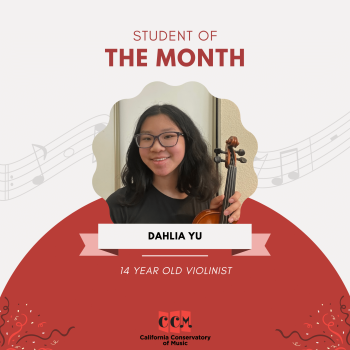
This December, we’re excited to highlight CCM violin student, Dahlia Yu, as our Student of the Month! Dahlia has been taking violin lessons at CCM for 1 year with teacher Shannon at our Sunnyvale location! She shows consistent hard work and determination in her violin studies. Teacher Shannon says that every time she is presented with an obstacle, she never gives up. Dahlia’s effort and perseverance shows massive growth in her musical journey and makes her a delight to teach.
Student of the Month
Dahlia
14
Shannon
I’ve been taking violin lessons for 1 year with CCM, but I started learning violin 2 years ago.
Practice makes progress, try to practice as often as you can.
I don’t have one
It’s challenging.
I don’t have one
Unfortunately no, but I hope to get a cat someday.
I play table tennis sometimes
I’m not sure yet. There are too many options.
Just being there and learning. I don’t have any particular moment that stands out as the most memorable.
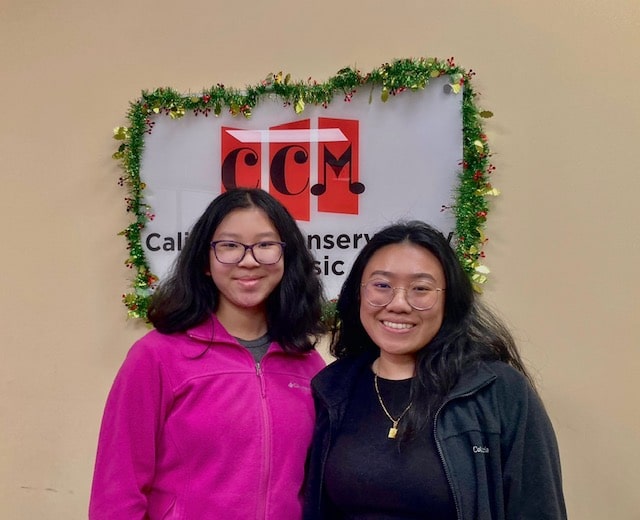
Parent Spotlight – Sarah Yu
Regarding violin instruction, what are you most proud of your child accomplishing?
I am very proud of Dahlia’s persistence and grit.
What advice would you give a new parent starting in the program?
It would be better to let our kids develop and find contentment and passion with the instrument they are playing, and to help them build confidence by supporting them when they are ready.
Why did you decide to give your child a musical upbringing?
Music is extraordinary and magical. It will take you to another world where you can be exposed to happiness and delight; it can bring you excitement and impression; or sometimes it could be dejection; it also could cure a downheartedness and dispiritedness. Music has a tremendous way of expression when words are inadequate. I hope she will find love and joy through this marvelous instrument while gaining proficiency.
Sign up for your free trial lesson at the California Conservatory of Music!

Benefits of Music Education: What Every Parent Should Know

As the year draws to a close, parents often reflect on the past and plan for their children’s future. Music education is a gift that can have a profound impact on a child’s development, one that extends far beyond the festive season. At the California Conservatory of Music (CCM), we understand the myriad of benefits that learning an instrument can offer to a young mind and spirit. This end-of-year period, filled with reflection and resolution, is the perfect time to consider the enduring value of music lessons.
The Multifaceted Benefits of Music Education
Intellectual Benefits
When a child begins to learn music, they embark on a journey that will challenge and enrich their intellect, emotional depth, and social interactions. Studying music has been shown to significantly enhance cognitive development. A well-rounded music education strengthens learning skills, sharpens memory, and can lead to higher academic achievement. As children navigate through complex rhythms and melodies, they are also developing critical thinking and problem-solving abilities.
Emotional Benefits
But the benefits of music education are not confined to intellectual growth alone. On an emotional level, music provides a profound avenue for self-expression and emotional release. Children learn to communicate their feelings through the medium of sound, which can be especially valuable during their developmental years. The practice required to master an instrument teaches discipline, patience, and the understanding that persistence leads to reward. These lessons in emotional maturity are crucial as children grow and face life’s challenges.
Social & Physical Benefits
Socially, music fosters a sense of community and collaboration. Children learn the importance of teamwork, listening, and the joy of shared accomplishments. They also develop a sense of cultural awareness and appreciation for diversity through the exploration of music from different traditions and parts of the world.
Furthermore, music education is also beneficial for physical development. Playing an instrument improves hand-eye coordination and fine motor skills. This physical aspect of music education often goes unnoticed, but it is integral to a child’s overall motor development.
A New Year, A New Musical Beginning
The spirit of giving and new beginnings, presents an opportune moment to introduce children to music education. Whether it’s the gift of their first instrument during the holidays or the start of lessons, these opportunities set children on a path of artistic and personal growth. CCM is proud to offer a free trial lesson to every new student. The free trial lessons are an invitation to experience the transformative power of music without any initial commitment.
CCM: A Community of Musical Excellence
Our commitment at CCM is to foster a nurturing environment where children can grow musically and personally. Our experienced instructors are dedicated to guiding each student through personalized lessons that cater to individual learning styles and goals. As we look to the New Year, we invite parents and guardians to explore the potential of music education with us.
The benefits of music education are as varied as they are significant. From cognitive and emotional development to social skills and physical coordination, learning music equips children with a diverse set of tools for life. As December unfolds with its message of peace and renewal, consider the lifelong gift of music education for your child. We at CCM are here to welcome you into our community, where education, artistry, and the joy of music come together to create a harmonious start to a New Year. Visit our website to learn more and to sign up for a complimentary trial lesson. Let’s make this holiday season the beginning of a musical adventure that will last a lifetime.
Sign up for a free trial lesson at The California Conservatory of Music!

